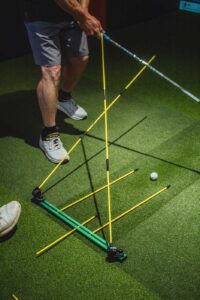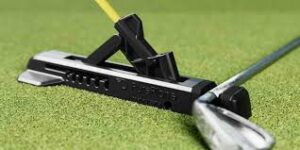The Swing Plate Review: Can this steel plate fix your swing?
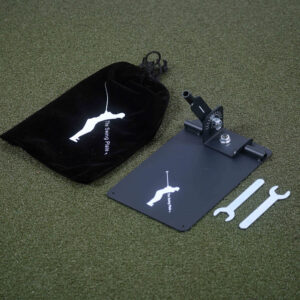
Birdie Score
Price
$69
One-Putt Summary
A rock-solid steel alignment stick holder that makes mat practice work, but at roughly $70 you're paying a premium price for what amounts to an adjustable metal bracket with holes; even worse of a deal if you're a lefty
Fairways (Pros)
- ✓ Steel = Durable
- ✓ Works effectively off mats
- ✓ Pick the angle you want; no fixed angles
Hazards (Cons)
- ✗ Cost
- ✗ Requires you to keep a wrench with you to tighten the bolt
- ✗ Ground alignment worthless for leftys
Best For
Mid-to-high handicappers who practice on mats who want the ultimate in angle selection
The Swing Plate Review: Can a Metal Base Really Fix Your Slice?
One-Putt Summary
A brutally simple steel platform that transforms alignment sticks into a precision swing lab—expensive for what it is, but game-changing if you practice on mats or indoors.
What You Need to Know Before You Buy
Let me cut straight to it: The Swing Plate is a weighted metal base that holds alignment sticks at adjustable angles. That’s it. No electronics, no fancy tech, just cold-rolled steel doing one job exceptionally well—making alignment stick drills possible anywhere, especially on those rock-hard range mats where you can’t stick anything into the ground.
Created by UK PGA Professional Jamie Brittain during the 2020 lockdowns, this device was born from necessity when coaches needed reliable ways to set up drills indoors. The concept is almost laughably simple: take the most universally accepted training tool in golf (alignment sticks) and give them a stable, adjustable platform that works on any surface.
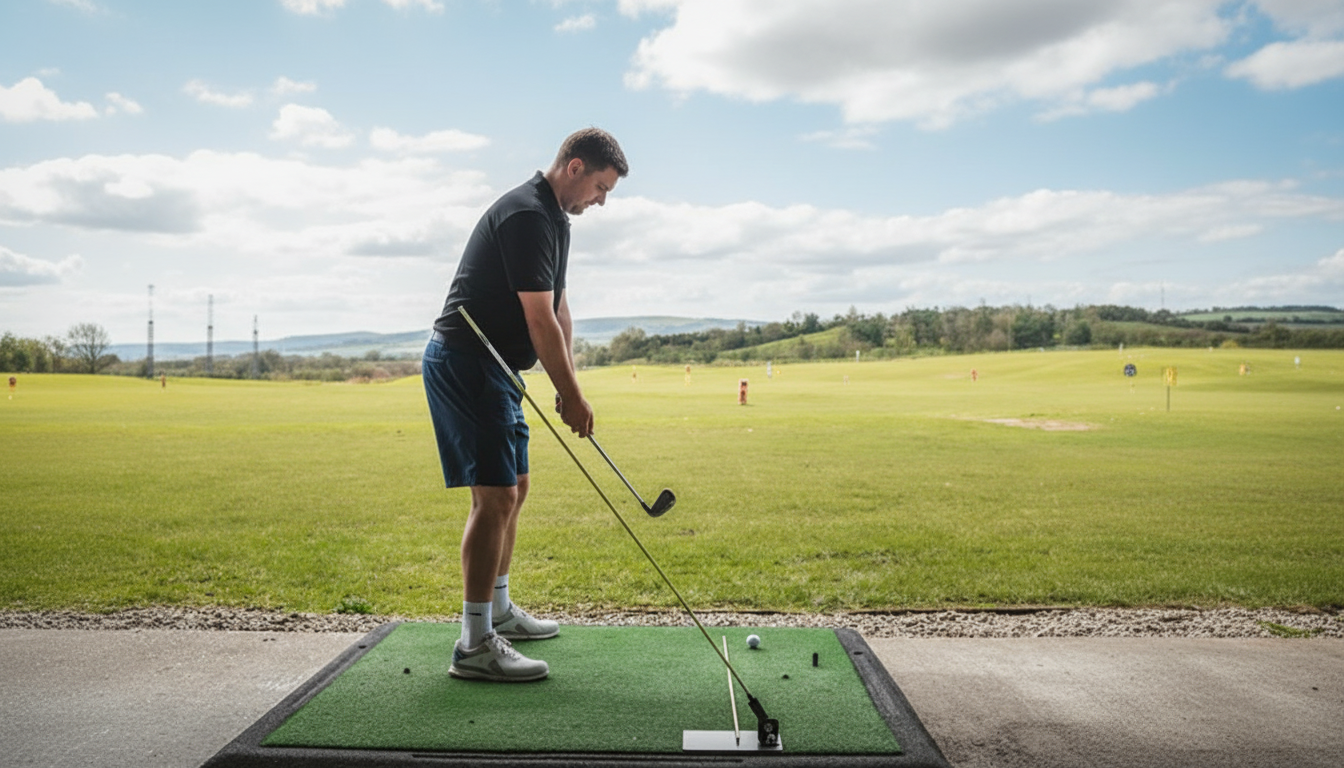
Best For
Mid-to-high handicappers (12-25) who battle an over-the-top swing path, practice primarily on mats or indoors, and value structured drill work over mindless ball-beating. Also essential for teaching pros who need quick setup between students.
The Swing Plane Problem (And How This Actually Fixes It)
Here’s the dirty truth about golf instruction: everyone tells you to “swing on plane,” but nobody gives you an easy way to feel what that means when you’re standing on a concrete-backed driving range mat.
The Swing Plate addresses the single biggest obstacle to effective practice in modern golf—the inability to anchor alignment sticks into artificial surfaces. If you’ve ever tried wedging a stick into a range basket or balancing it against your bag, you know the frustration. It’s imprecise, unstable, and honestly kind of embarrassing.
What It Claims to Fix
The marketing focuses on correcting:
- • Over-the-top swing path (the slice-causing demon)
- • Flat backswing plane
- • Excessive body sway during takeaway
- • Poor weight transfer
- • Inconsistent body rotation
What It Actually Fixes (According to Real Golfers)
Over-the-Top Swing Path Correction
User consensus overwhelmingly identifies over-the-top swing path correction as the device’s most consistently effective application. YouTube instructors, forum warriors, and everyday golfers repeatedly demonstrate using this thing to create a visual barrier that prevents that steep, out-to-in downswing motion that sends your Pro V1 into the adjacent fairway.
One instructor put it bluntly: “I use it with my students primarily for correcting over-the-top swings. You set up the stick at the proper plane angle and the immediate feedback when they hit the stick tells them exactly when they’ve come over”.

The Critical Nuance Most Reviews Miss
The Swing Plate addresses the visual effect of swing faults, not necessarily the biomechanical root causes. One detailed instructor video emphasized: “You can do over-the-top fixing drills all day and get nowhere because that is not fixing the reason why you swing over the top”.
Think of it this way: if your over-the-top move comes from early hip thrust or lack of hand depth in transition, this device will make you aware of the problem through instant feedback, but you’ll need to address those root causes separately. It’s a swing path monitor, not a swing path magician.
Build Quality: Overbuilt in the Best Way
Let’s talk about what you’re actually getting for your money. The standard base weighs 800 grams (1.76 lbs) of cold-rolled steel. Users consistently describe it as “solid,” “robust,” and something that “could withstand serious abuse” and “will last forever”. No verified reports of structural failure exist in any review corpus I found—this thing is built like it could survive a direct meteor strike.
The Dual Pro model (1.5 kg) features two adjustable arms, allowing you to create a “corridor” for your club to swing through. It’s heavier, bulkier, and frankly overkill unless you’re a teaching pro running students through rapid-fire drills.
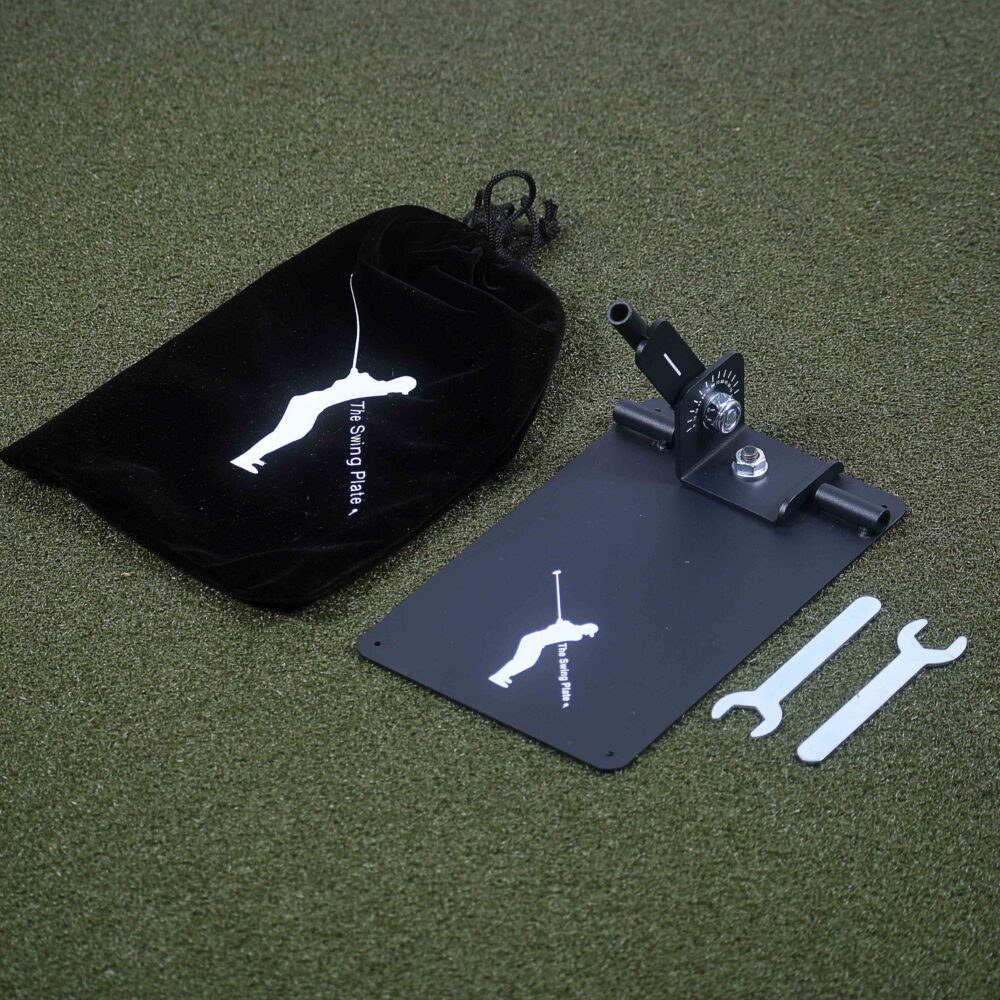
The Adjustment Mechanism
The arm adjusts by hand through a full 0-90 degree range. A wrench is included for permanent positioning, though routine adjustments require no tools. The 2021+ models added a calibrated angle sticker to address the most common complaint from early adopters: “The one thing I would like to see in The Swing Plate 2.0 is markings on the arm so that you can set it up precisely”.
Setup time? Consistently described as taking “just a few moments” or “seconds”. One reviewer reported going from box to ready-to-hit in under two minutes with zero prior experience.
The Durability Asterisk
A few users mention the adjustable arm becoming loose with repeated heavy use, requiring periodic wrench tightening. This isn’t widespread—maybe 5-10% of long-term users report it—but it’s worth noting if you’re planning 200+ sessions per year.
Build Quality Score
Exceptional steel build; minor deduction for periodic wrench tightening
18/20
Effectiveness: The Drill-Mode vs. Real-Game Reality Check
Here’s where we separate marketing promises from range reality.
Immediate Results: Outstanding (8.5/10)
Users universally report strong immediate swing changes when actively using The Swing Plate during practice sessions. The physical constraint creates exaggerated proprioceptive awareness that forces temporary path alterations. One reviewer demonstrated a student’s slice reduction after “thirty minutes of practice swings,” showing fades traveling 220-235 yards instead of severe slices.
The feedback is binary and brutal: you either hit the stick or you don’t. No ambiguity, no interpretation required, no launch monitor data to overthink. “With every drill, the feedback is very clear. If you’re swinging under or over an alignment stick, there’s no question whether or not you hit it”.
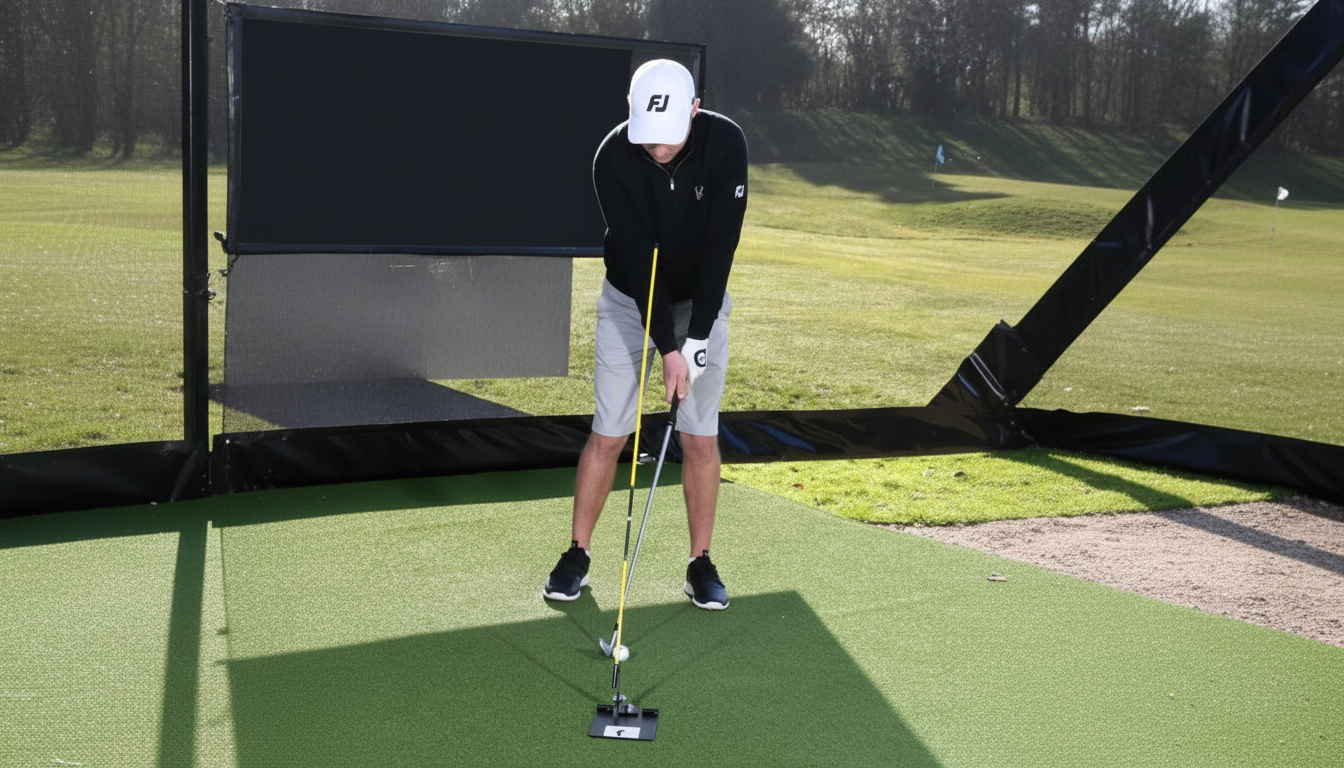
Transfer to On-Course Performance: Good (7/10) with Proper Protocol
This is where training aids live or die, and The Swing Plate requires deliberate integration to avoid becoming a crutch.
The Critical Limitation
Improvements achieved with the device don’t automatically transfer to unaided swings unless properly integrated. One video review explicitly states: “You would do that for three or four shots, get the feeling, then remove it so then when you go on the golf course you’re not thinking where’s my swing plate”.
User-Recommended Protocol for Lasting Change:
- 1. Identify the root biomechanical cause (steep shaft, early hip thrust, etc.)
- 2. Work on root cause correction first with specific drills
- 3. Use Swing Plate to groove the proper plane effect with slow, deliberate practice swings
- 4. Alternate: 3-4 swings with device, 3-4 without, repeat
- 5. Gradually reduce device dependency as the motor pattern ingrains
One instructor fixed a student’s early extension “in just one month” but emphasized it required following a specific three-step roadmap combining root cause work, visual drill work with The Swing Plate, and proper practice methodology.
Effectiveness Score
Strong immediate results; requires proper protocol for lasting change
23/30
Versatility: Way More Than Swing Plane
Users discovered effective applications for chipping, pitching, and bunker play beyond the primary full-swing focus. The adjustable angle helps dial in proper wedge plane and control drills around the greens.
One user emphasized: “It has helped me with my swing plane and even more so with my chipping and pitching techniques”. His coach added that it made him aware of the correct path differences between short game and full swing technique.

Other Verified Applications
- ✓ Weight transfer drills: Position behind your trail hip to prevent slide
- ✓ Backswing sway elimination: Angle next to your lead leg to monitor lateral movement
- ✓ Body rotation checkpoints: Set up perpendicular to target line at address
- ✓ Putting path work: Low-angle setup for stroke plane consistency
- ✓ Indoor winter practice: Multiple users cite maintaining swing mechanics during off-season or bad weather
The Versatility Gap
While functional for multiple drill types, The Swing Plate falls behind competitors in overall versatility. Many competing training bases offer additional ground alignment options for target line work—features completely absent here.
Critical limitation for left-handed golfers: The ground alignment stick holder only accommodates right-handed setups. Left-handed players can still use the angled arm for swing plane work, but lose the dual-stick “corridor” functionality that right-handed golfers enjoy. This is a significant oversight for a premium-priced product.
Versatility Score
Limited vs. competitors; ground alignment only supports righties
2/5
Ease of Use: Quick Setup, Learning Curve for Drills
The Portability Paradox
Here’s the contradiction that drives people nuts: the marketing says “fits in your golf bag,” and technically it does. But multiple reviewers express reluctance to carry it regularly due to fear of damaging golf bag zippers or pockets.
One stated bluntly: “It’s heavy enough that I wouldn’t store it in my golf bag for fear of ripping a pocket or zipper”.
The Reality
It’s transportable (throw it in your trunk for range sessions) but not truly portable in the “carry it everywhere” sense. Think of it as a range essential rather than a bag staple. It comes with a velvet drawstring pouch, which is nice but doesn’t change the weight physics.
Safety and Setup Reality
✓ The Club Damage Risk
Multiple sources warn about the potential to hit the metal plate itself rather than just the alignment stick, which could damage clubs. Safety recommendations include using pool noodles or foam tubing on sticks and maintaining distance from the base unit.
This is real but manageable. Start with slow-motion swings, maintain proper distance, and consider the pool noodle trick for peace of mind.
✗ The Learning Curve
Some users report initial confusion about which drills to use and how to set proper angles. The company provides tutorial videos on their website, but several reviewers wished for more comprehensive printed instructions or quick-start guides.
If you’re a visual learner, you’ll appreciate the video library. If you want a laminated card with “Top 5 Drills,” you’ll be disappointed.
Ease of Use Score
Quick setup but requires learning proper drill applications
14/20
Value Analysis: The $90 Question
Let’s address the elephant on the range: this is essentially a hinged piece of metal that holds sticks. Is it worth $85-100?
Standard Model
$85-90
(base only)
With Alignment Sticks
$99-115
(bundle)
DIY Alternative
$5-20
(PVC/bucket)
The “Hell No” Camp
A vocal subset of users perceive the device as expensive for what amounts to “a metal plate that holds alignment sticks”. Reddit discussions frequently mention DIY alternatives using PVC pipe, upside-down range buckets, or simple 2×4 wood blocks with drilled holes at $5-$20 cost.
Fair Alternatives if You’re Handy:
- • PVC pipe + T-connectors: $6-20, functional but less stable
- • Upside-down range basket + hardware store driveway markers: $15-20, crude but works
- • 2×4 wood block with angled drilled hole: $5-10, fixed angle limitation
- • 3D printed base (if you have printer access): $5-10 material cost
The “Absolutely” Camp
For teaching professionals and dedicated amateurs who practice primarily on mats or indoors, users consistently view it as good value compared to electronic training aids or launch monitors.
The Value Equation Breaks Down Like This:
Total rational value: ~$80-115
…which actually aligns with the $85-100 price point.
My Take
The Swing Plate occupies a “sweet spot” between budget generic options and premium multi-axis systems. If you practice on grass 90% of the time, save your money and just push sticks into the ground. If you’re a mat warrior or indoor practitioner, this thing pays for itself in 10-15 focused practice sessions by enabling drills that were previously impossible.
Value Score
Justified for mat practitioners; expensive vs. alternatives
17/25
Who Should Buy This (And Who Shouldn’t)
Ideal Buyer Profile
- ✓ Handicap: 12-25, actively working to break 90 or reach mid-80s consistency
- ✓ Specific swing demons: Chronic over-the-top/slice pattern, inconsistent swing plane, backswing sway or excessive lateral movement, difficulty visualizing proper angles
- ✓ Practice environment: Practices on mats or indoor facilities (not grass ranges), willing to dedicate 20-30 minute focused drill sessions, values structured practice over mindless range time
- ✓ Learning style: Comfortable with video tutorials or has instructor guidance
- ✓ Budget mindset: Willing to invest $85-115 for a durable, multi-year training tool without batteries, software updates, or subscriptions
Also Excellent For
Teaching Professionals
PGA coaches frequently request it for lesson bags due to quick setup and clear student feedback
Single-Digit Handicaps
Players fine-tuning specific plane feels or maintaining off-season mechanics
Short Game Specialists
Applying plane drills to chipping, pitching, bunker technique
Indoor Practice Enthusiasts
Year-round practitioners who need compact, effective tools that work on mats
Hard Pass If You’re…
- ✗ Budget-conscious with grass range access: You can replicate 90% of functionality by pushing sticks into turf
- ✗ A complete beginner without instruction: Total novices lacking baseline swing understanding may struggle to apply drills effectively
- ✗ Tech-data-driven: Prefer quantitative feedback from launch monitors over physical/visual guides
- ✗ Anti-training-aid philosophy: Believe aids create dependency or prefer pure swing instruction
Fairways & Hazards: The Honest Pros and Cons
Fairways (Strengths)
- ✓ Unlocks impossible drills: Enables alignment stick work on mats, concrete, basement floors where traditional anchoring fails
- ✓ Instant, binary feedback: Physical sensation of club-to-stick contact provides unambiguous feedback
- ✓ Built for the apocalypse: Cold-rolled steel construction with zero verified structural failures
- ✓ Legitimate short game applications: Effective chipping and pitching plane work beyond full-swing focus
- ✓ Lightning setup: Setup takes “just a few moments” or “seconds”
Hazards (Limitations)
- ✗ Weight creates bag portability concerns: 800g-1.5kg weight causes fear of damaging zippers or pockets
- ✗ Price-to-simplicity ratio questioned: $85-100 when DIY alternatives exist at $5-20
- ✗ Treats symptoms, not root causes: Visual plane guides address effects rather than biomechanical root causes
- ✗ Alignment sticks sold separately: Base-only version frustrates buyers expecting complete package
- ✗ Original model lacks angle markings: Prevents precise repeatability (2021+ models fixed this)
Frequently Asked Questions
Can this actually fix my slice?
Is it worth it if I only practice on grass ranges?
Will this fit in my golf bag?
Do I need to buy alignment sticks separately?
How does this compare to a $20 DIY PVC version?
Can beginners use this without a coach?
Does it work for left-handed golfers?
What’s the difference between the standard and Dual Pro models?
The Bottom Line
The Swing Plate is a brutally honest training aid: it does exactly what it claims (hold alignment sticks at adjustable angles on any surface) with exceptional build quality and zero pretense. It’s not revolutionary—it’s evolutionary, taking the most basic training tool in golf and making it universally accessible.
For golfers who practice primarily on mats or indoors, this device solves a genuine problem with elegant simplicity. The immediate feedback is outstanding, helping groove proper plane awareness in minutes. But lasting improvement requires deliberate practice protocols and addressing root biomechanical causes, not just drilling with the device in place.
The $90 price point will always be polarizing for something this mechanically simple. But consider this: it has no batteries to die, no software to update, no subscription fees, and construction quality that suggests it’ll outlast your current set of irons. If you’re the type who values precision practice over mindless ball-beating, and you’re stuck on mats or indoors, this thing earns its keep.
Skip it if you’ve got consistent grass range access and basic DIY skills. Buy it if you’re serious about structured practice in modern training environments. Either way, stop blaming your slice on your equipment—this thing will make damn sure you know exactly where your club is going.
Performance Scoring Breakdown
| Category | Score | Max |
|---|---|---|
| Effectiveness | 23 | 30 |
| Build Quality & Durability | 18 | 20 |
| Ease of Use | 14 | 20 |
| Value for Money | 17 | 25 |
| Versatility | 2 | 5 |
| TOTAL | 74 | 100 |
Solid “C+” Training Aid
Final Verdict: 74/100
Highly effective at its core mission, built to last decades, but expensive for what amounts to a smart metal base. Limited versatility compared to competitors and left-handed golfers lose key functionality.
⛳ The 19th Hole: Final Verdict
A rock-solid steel alignment stick holder that makes mat practice work, but at roughly $70 you're paying a premium price for what amounts to an adjustable metal bracket with holes; even worse of a deal if you're a lefty
Birdie Score: 80/100

